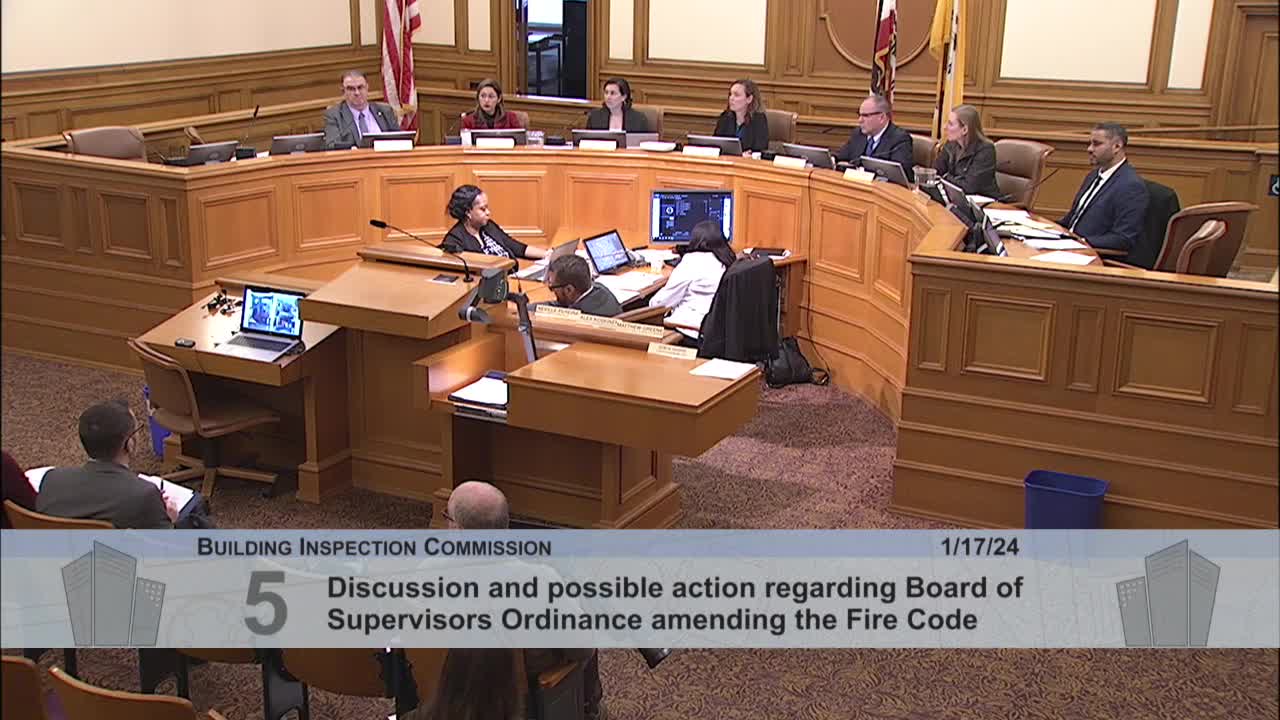San Francisco commissioners debate 5-foot access rule for ADUs and lot splits
January 17, 2024 | San Francisco City, San Francisco County, California

This article was created by AI summarizing key points discussed. AI makes mistakes, so for full details and context, please refer to the video of the full meeting. Please report any errors so we can fix them. Report an error »

A pivotal discussion unfolded during the recent San Francisco Building Inspection Commission meeting, focusing on proposed changes to fire safety regulations tied to lot splits and accessory dwelling units (ADUs). The key proposal aims to establish a minimum five-foot access requirement for new residential buildings, a shift from the current four-foot standard mandated by state law under SB 9.
Commissioners expressed a mix of support and concern regarding the implications of this change. Proponents, including Fire Department representatives, argued that the increased access width is essential for ensuring adequate emergency response in densely populated areas. Fire Marshal Coughlin emphasized the necessity of this standard to enhance safety, stating, "This is the bare minimum that they need to be able to address fire concerns in the back of these lots."
However, some commissioners voiced apprehension that the stricter requirement could deter property owners from pursuing lot splits, ultimately hindering housing development in a city grappling with a housing crisis. Commissioner Chavez articulated this concern, suggesting that the additional foot could be a significant barrier for homeowners looking to create ADUs or split their lots. "We have to balance existing conditions with future conditions," he noted, highlighting the need for a nuanced approach that considers the unique characteristics of San Francisco's housing landscape.
Public comments echoed these sentiments, with local architects and housing advocates cautioning against potential unintended consequences of the proposed regulations. They urged the commission to consider the impact on housing production and to seek a middle ground that prioritizes both fire safety and the need for increased housing availability.
As the commission deliberates, the outcome of this proposal could set a precedent for how San Francisco navigates the intersection of fire safety and housing development, with significant implications for the city's future growth and safety standards. The commission is expected to continue discussions and may release an informational bulletin to clarify the new requirements if the proposal is approved.
Commissioners expressed a mix of support and concern regarding the implications of this change. Proponents, including Fire Department representatives, argued that the increased access width is essential for ensuring adequate emergency response in densely populated areas. Fire Marshal Coughlin emphasized the necessity of this standard to enhance safety, stating, "This is the bare minimum that they need to be able to address fire concerns in the back of these lots."
However, some commissioners voiced apprehension that the stricter requirement could deter property owners from pursuing lot splits, ultimately hindering housing development in a city grappling with a housing crisis. Commissioner Chavez articulated this concern, suggesting that the additional foot could be a significant barrier for homeowners looking to create ADUs or split their lots. "We have to balance existing conditions with future conditions," he noted, highlighting the need for a nuanced approach that considers the unique characteristics of San Francisco's housing landscape.
Public comments echoed these sentiments, with local architects and housing advocates cautioning against potential unintended consequences of the proposed regulations. They urged the commission to consider the impact on housing production and to seek a middle ground that prioritizes both fire safety and the need for increased housing availability.
As the commission deliberates, the outcome of this proposal could set a precedent for how San Francisco navigates the intersection of fire safety and housing development, with significant implications for the city's future growth and safety standards. The commission is expected to continue discussions and may release an informational bulletin to clarify the new requirements if the proposal is approved.
View full meeting
This article is based on a recent meeting—watch the full video and explore the complete transcript for deeper insights into the discussion.
View full meeting
